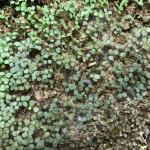Western flower thrips (Frankliniella occidentalis) were observed in greenhouses and Rhizoctonia damping off (Rhizoctonia solani) of seedlings was confirmed in the UMass Extension Plant Diagnostic Lab last week.
Thrips
Western flower thrips are one of the more damaging insect pests of greenhouse crops, and among the most difficult to control. Western flower thrips feed on many crops and crop stages including plugs, cuttings and small plants. They have a wide host range and have a tendency to hide in flower buds, which makes it difficult to detect them before feeding damage is visible. They feed by piercing plant cells with their mouthparts. This causes the collapse of plant cells which results in deformed flowers, leaves and shoots. Silvery-flecked scars and small black fecal spots may be seen on the leaves. Thrips also transmit tospoviruses – tomato spotted wilt virus (TSWV) and impatiens necrotic spot virus (INSV). Virus infected plants may not show symptoms initially but they usually become unmarketable.
Monitor your crops for thrips early in the production cycle because populations spike during flowering due to the availability of pollen, which they also feed on. Control after flowering is also more difficult because of potential flower sensitivity to pesticide applications. Management is also more difficult when plants are larger because thrips have more places to hide from pesticide coverage. Scout for thrips by tapping foliage before bloom, and flowers when they are present, over a white surface and looking for small nymphs. Use yellow or blue stick cards to monitor for adult thrips.
Biological control of thrips should be started early before populations increase. Commercially available biological control agents include: entomopathogenic nematodes (Steirnernema feltiae), predatory bugs (Orius species) and predatory mites (Stratiolaepsis scimitus formerly Hypoaspis miles, Neoseilus cucumeris, and Ambyseius swirskii). Consult your biocontrol agent supplier for more information.
Some of the insecticides available for control of thrips include Pylon, Overture 35 WP, Mesurol 75 W, and Mainspring. Insecticides with contact or translaminar activity are more effective. Systemic insecticides do not move into the flowers and so they only suppress thrips on the foliage. Make sure to rotate between different classes to prevent resistance development.
For more information on control of thrips, consult the latest edition of the New England Floriculture Crops Pest Management Guide.
Thrips Resources:
- Dan Gilrein, Cornell Extension: Come to Grips with Thrips: https://e-gro.org/pdf/2016_528.pdf
- Jeanne Himmelein, Michigan State University Extension: Understanding western flower thrips: http://msue.anr.msu.edu/news/understanding_western_flower_thrips
- Tina Smith, UMass Extension: Western Flower Thrips, Management and Tospoviruses: http://ag.umass.edu/greenhouse-floriculture/fact-sheets/western-flower-thrips-management-tospoviruses
Rhizoctonia Damping-Off of Greenhouse Crops
 Damping-off is a disease of germinating seeds and seedlings caused by fungi or fungi-like organisms such as Pythium, Phytophthora, Rhizoctonia and Alternaria.
Damping-off is a disease of germinating seeds and seedlings caused by fungi or fungi-like organisms such as Pythium, Phytophthora, Rhizoctonia and Alternaria.
Rhizoctonia damping-off (Rhizoctonia solani) can cause seed rot, root rot and lesions on plant hypocotyls. Damping-off occurs when the germinating seedlings are infected before or just after emergence. On the hypocotyl lesions are reddish brown and sunken. Diseased seedlings collapse due to cankers that girdle the hypocotyl. It is difficult to distinguish the symptoms of rhizoctonia damping-off from damping-off caused by other organisms. When damping-off disease occurs, send a sample to the UMass Extension Plant Diagnostic Lab to have the cause determined.
Rhizoctonia can persist in the soil as hyphae and sclerotia. Warm soil temperatures (above 70⁰ F) and even moderate soil moisture favors the growth of the fungus. The fungus can easily be spread to the growing medium by soiled tools, hands, hoses and splashing water from infected soil. To prevent contamination of growing media, keep flats and plug trays off of the floor, and hang up hose ends.
Fungicides available for control of Rhizoctonia include: Banrot 40 WP, Affirm WDG, Emblem/Medallion WG, Empress Intrinsic, and Heritage WG. Make sure to rotate between different classes to prevent resistance development.
For a complete list of fungicides for control rhizoctonia consult the latest edition of the New England Floriculture Crops Pest Management Guide.
Damping-Off Resources:
- Mary Hausbeck, Michigan State University: R is for Rhizoctonia rot on ornamentals: http://msue.anr.msu.edu/news/rhizoctonia_rot_on_ornamentals
- UMass Extension: Damping-Off of Bedding Plants and Vegetables: http://ag.umass.edu/greenhouse-floriculture/fact-sheets/damping-off-of-bedding-plants-vegetables
- Leanne Pundt, University of Connecticut: Damping-off of Ornamental and Vegetable Seedlings: http://bit.ly/2p77C6g
Geoffrey Njue, UMass Extension with contributions from Angela Madeiras, UMass Extension and Jim Mussoni